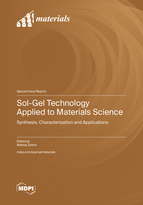Sol-Gel Technology Applied to Materials Science: Synthesis, Characterization and Applications
A special issue of Materials (ISSN 1996-1944). This special issue belongs to the section "Materials Chemistry".
Deadline for manuscript submissions: closed (20 December 2023) | Viewed by 16104
Special Issue Editor
Interests: functional inorganic materials; mixed metal oxides; nanomaterials; inorganic biomaterials; thin films; ceramics
Special Issues, Collections and Topics in MDPI journals
Special Issue Information
Dear Colleagues,
Rapid development of the world highly demands new materials, nanostructures and multicomponent composites with specific chemical and physical properties, which meet the requirements of modern technologies. The employment of appropriate synthetic approaches is crucial for the preparation of inorganic materials with designed microstructure and properties. Among the others, the sol-gel method is very well known for its versatility, simplicity, time- and cost-efficiency. The mixing of starting materials on an atomic level provides high homogeneity and stoichiometry of the products, allowing to obtain high-quality materials at low temperature. The versatility of sol-gel method allows for the development of materials for a wide range of applications in electronics, optoelectronics, catalysis, biomedicine and many other areas. The scope of this Special Issue, “Sol-Gel Technology Applied to Materials Science: Synthesis, Characterization and Applications”, of Materials is focused on, but not limited to, the preparation, characterization and application of functional inorganic materials, as well as hybrid materials, which are important in the field of electronics, optics, biomedicine and others. It is my pleasure to invite you to submit your works in the form of full research articles or reviews related to the investigation of bulk materials, nanomaterials and thin films.
Dr. Aleksej Zarkov
Guest Editor
Manuscript Submission Information
Manuscripts should be submitted online at www.mdpi.com by registering and logging in to this website. Once you are registered, click here to go to the submission form. Manuscripts can be submitted until the deadline. All submissions that pass pre-check are peer-reviewed. Accepted papers will be published continuously in the journal (as soon as accepted) and will be listed together on the special issue website. Research articles, review articles as well as short communications are invited. For planned papers, a title and short abstract (about 100 words) can be sent to the Editorial Office for announcement on this website.
Submitted manuscripts should not have been published previously, nor be under consideration for publication elsewhere (except conference proceedings papers). All manuscripts are thoroughly refereed through a single-blind peer-review process. A guide for authors and other relevant information for submission of manuscripts is available on the Instructions for Authors page. Materials is an international peer-reviewed open access semimonthly journal published by MDPI.
Please visit the Instructions for Authors page before submitting a manuscript. The Article Processing Charge (APC) for publication in this open access journal is 2600 CHF (Swiss Francs). Submitted papers should be well formatted and use good English. Authors may use MDPI's English editing service prior to publication or during author revisions.
Keywords
- functional materials
- magnetic materials
- ferroelectric materials
- piezoelectric materials
- optical materials
- biomaterials
- hybrid materials
- processing routes
- ceramics
- thin films







